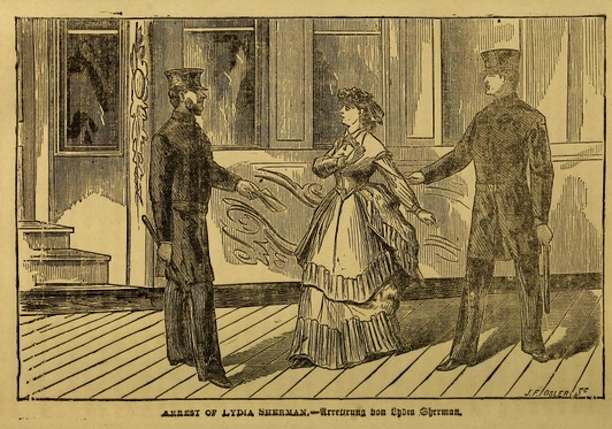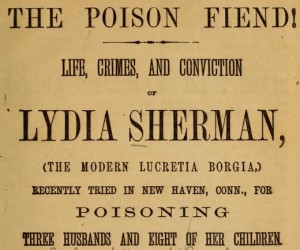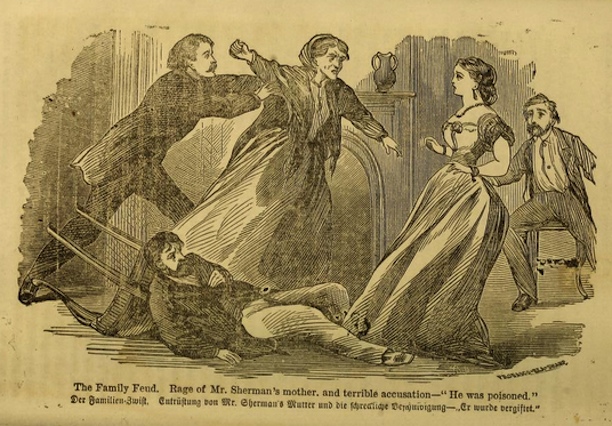Between 1864 and 1871 Lydia Sherman killed three husbands and several children, including her own. Authorities arrested her in New Brunswick, New Jersey, in June 1871 for killing a third husband, Horatio Sherman, and, in a New Haven courtroom in 1873, she received a life sentence for second-degree murder.
Sherman was born Lydia Danbury in New Jersey in 1824 and became orphaned as an infant. Her uncle raised her, and when she was 16 she began working as a tailor. When she was 17 she met her first husband, Edward Struck, at a Methodist church they both attended, and they soon married. A widower with two children, Struck worked as a police officer in the New York City suburb of Yorkville. Within seven years he and Lydia had six children together. Life in the Struck household began to decline, however, when Edward lost his job, fell into a serious depression, and proved unable to find more work. Instead of having him committed to a mental health institution, Lydia poisoned Struck, killing him. Within a number of weeks, she also killed their three youngest children. Over the next several months, while she worked as a nurse, her remaining three children all fell ill and quickly died. Somehow her crimes went unnoticed and Lydia moved to Connecticut.
Lydia Sherman Comes to Connecticut
In 1867, Sherman took a nursing job in Stratford and soon met wealthy Litchfield farmer and fisherman Dennis Hurlburt. Although Hurlburt was many years her senior, Sherman married him. She was careful, however, not to raise suspicion of a young wife with an old man who “possessed very few attractions, besides his property,” so publicly, she doted on him. After the marriage, Hurlburt altered his will leaving everything to his new bride, and soon after that, Hurlburt took ill. Although doctors came to help the ailing man, Hurlburt died. Few at the time suspected foul play.
Shortly after Hurlburt’s death, Lydia applied to be the housekeeper for Derby resident Horatio N. Sherman. A recent widower, Sherman took care of his two children Ada and Frankie (also spelled Franky in documents). Lydia got the job—and the husband. Within a few months of her employment in the Sherman house, Horatio married Lydia. Not long after the marriage, Sherman’s infant son took ill and died. A few months after his son died, his teenage daughter also took ill and died. Soon after, Horatio Sherman was also dead. Mr. Sherman enjoyed drinking (and it was his liquor that contained the arsenic that quickly killed him. In her later confession, Lydia contended that she did not mean to kill him at all, only his children, and he may have accidentally ingested the arsenic thinking it was saleratus, a baking soda-like compound that, when mixed with cider, made it foam.)
Lydia proved unable to avoid suspicion this time around. Dr. Beardsley, a local physician from Yale College, having learned of Horatio Sherman’s abrupt and untimely death, ordered an autopsy and discovered poison. Consequently, the doctor exhumed the bodies of the Sherman children, as well as Dennis Hurlburt’s body, and discovered they were also poisoned.

Illustration of the “Arrest of Lydia Sherman” from the book The Poison Fiend! Life, Crimes, and Conviction of Lydia Sherman… by George L. Barclay, 1873.
Arrest and Trial of the Derby Poisoner
In June 1871, police arrested Lydia Sherman in New Brunswick, New Jersey, for the murder of her third husband, Horatio N. Sherman. She returned to Connecticut and was tried in New Haven in 1872. The jury found her guilty of second-degree murder. She was remanded to the New Haven jail while she waited for her sentence and in 1873 she made a full confession, admitting to poisoning her “three husbands and four children.” On January 11, 1873, Judge Sanford of New Haven sentenced Lydia Sherman to life in prison at Wethersfield State Prison.
In June 1877, Sherman escaped from prison under the watch of a “careless matron” and, with the help of friends, made her way to Providence, Rhode Island. She soon slipped up, however, and was caught after she gave a hotel proprietor’s wife two different names. She returned to the prison, and on May 16, 1878, after several weeks of illness, she died.

Detail from the title page of the book The Poison Fiend! Life, Crimes, and Conviction of Lydia Sherman… by George L. Barclay, 1873.
Despite Lydia’s death, her story lived on. In 1873 and in 1878, two different companies published her 1873 confession, to the delight of an eager and curious public. Accounts of her crimes vary, as do the number of children she killed. She confessed to three husbands and four children, but it is now believed that the total number of her victims may be as high as ten.









